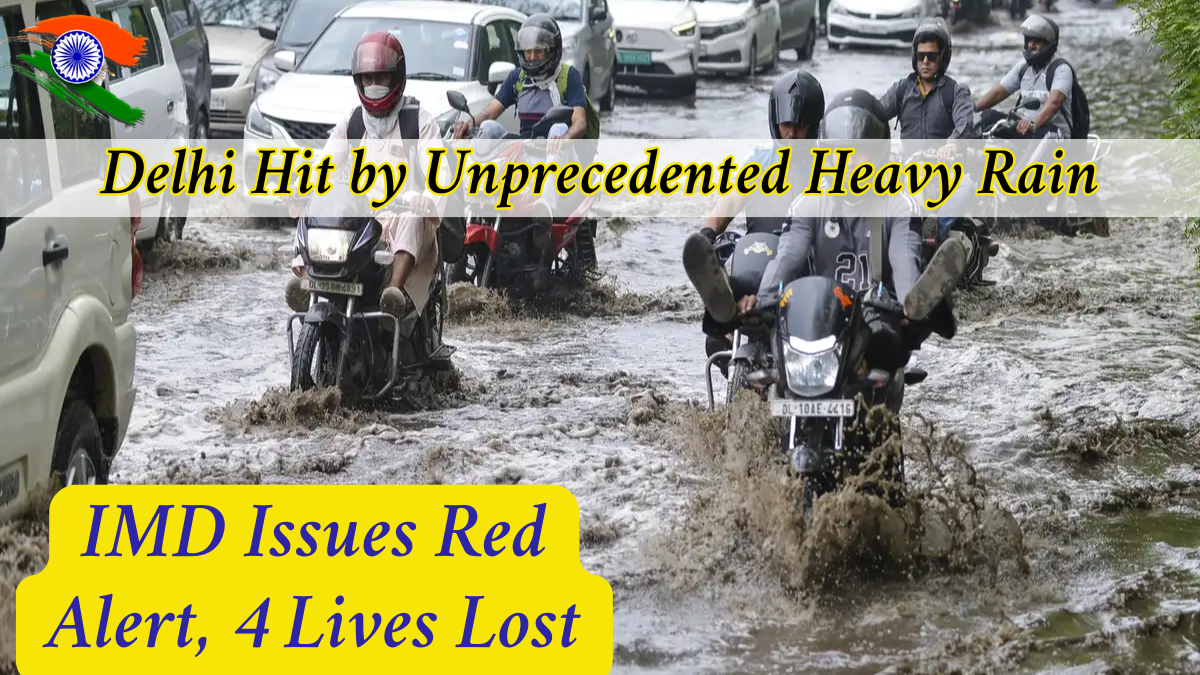On Friday, New Delhi experienced an unexpected downpour that took even the India Meteorological Department (IMD) by surprise. What was initially predicted as a moderate rainfall event turned into a torrential storm, leaving the city grappling with severe weather conditions, widespread damage, and tragic casualties. The IMD was forced to issue a red alert early in the morning as the rain intensified, and the storm caused significant disruptions throughout the capital.

This incident marks only the second time in the 21st century that Delhi has experienced such heavy rainfall in May, adding to the unpredictability and growing concerns about weather patterns in the region.
Table of Contents
Summary Table: Unprecedented Rainstorm Hits Delhi
Aspect |
Details |
|---|---|
Date of Event |
Friday, May 12, 2025 |
Red Alert Issued by IMD |
Yes, upgraded by 5 AM |
Rainfall Recorded |
77 mm at Safdarjung by 8:30 AM |
Fatalities Reported |
At least 4 deaths |
Maximum Wind Speed |
Up to 80 km/h |
Alert for Saturday |
Yellow Alert – light rain with 40-50 km/h winds expected |
Weather Forecast for Sunday |
Intermittent showers expected |
Cause of Storm |
Moisture-rich conditions due to extreme heat and a western disturbance |
Director of IMD |
Mr. M. Mohapatra |
Infrastructure Impact |
Waterlogging, uprooted trees, power outages |
Sudden Shift in Weather Causes Widespread Chaos
The weather on Friday morning in Delhi took a dramatic turn, as what was supposed to be a moderate rainfall event evolved into torrential showers accompanied by powerful gusty winds reaching speeds of up to 80 km/h. The unanticipated change left the city in chaos, with uprooted trees, waterlogged streets, and power outages reported across several areas.
The severe weather led to at least four fatalities, as people were caught off guard by the storm. The IMD, which had initially issued a warning for moderate rainfall, urgently upgraded the forecast to a red alert by 5 AM, signaling the severe nature of the event. However, the authorities had little time to prepare or respond to the scale of the storm, and its impact was immediately felt across Delhi.
By the time the IMD updated its website with the latest warnings and advisories, much of the city had already been hit by torrential rainfall and high winds. The storm caused significant damage to infrastructure, particularly in areas already prone to flooding and waterlogging. The strong winds also brought down trees, blocking roads and causing further disruption to the daily life of Delhi residents.
Rainfall Records and Alerts: A Historic Downpour
As the storm intensified, rainfall data began to roll in, and it became clear that Delhi had experienced a record-breaking weather event. According to the IMD, Safdarjung recorded 77 mm of rainfall by 8:30 AM, marking a dramatic shift from the originally predicted showers.
The intensity of the downpour was comparable to the severe rainfall caused by Cyclone Tauktae in May 2021, which resulted in 119.3 mm of rainfall in the city. The cyclone’s impact was one of the worst in recent years, and Friday’s storm proved to be almost as devastating, albeit without the influence of a cyclone.
Despite the severity of the storm, the IMD has issued a yellow alert for Saturday, indicating the possibility of light rain and winds reaching speeds of 40-50 km/h. The weather department has also forecasted intermittent showers through Sunday, which means Delhi will continue to experience unstable weather conditions over the next few days.
IMD Director Explains the Unpredictability of Pre-Monsoon Weather
Following the event, Mr. M. Mohapatra, Director of the IMD, explained that such extreme weather conditions were difficult to predict, especially during the pre-monsoon season. According to Mohapatra, thunderstorms are expected over Northwest India in the coming days, but the exact intensity and impact remain uncertain.
“The formation of thunderstorms during the pre-monsoon season is highly unpredictable,” said Mr. Mohapatra. He further elaborated that last week’s intense heat had created moisture-rich conditions over the Bay of Bengal and Arabian Sea, which led to the formation of powerful storm systems. Additionally, a western disturbance, a weather phenomenon characterized by moist winds from the west, played a crucial role in amplifying the storm’s intensity.
Despite some sunny intervals on Friday, temperatures remained unusually low throughout the day, contributing to the unexpected nature of the storm. While technological advancements in weather forecasting have significantly improved over the years, Friday’s events proved that nature still has the ability to outpace predictions, reminding us of the inherent unpredictability of weather patterns.
Impact on Delhi’s Infrastructure and Public Services
The unexpected rainfall brought significant challenges to the already overburdened infrastructure of Delhi. Many parts of the city experienced severe waterlogging, which led to traffic snarls and delays. The waterlogged streets posed a threat to pedestrians and vehicles alike, with many roads becoming impassable due to the rising water levels.
Furthermore, uprooted trees caused blockages on major roads, and in some cases, electrical poles were damaged, resulting in power outages in multiple areas. The rapid onset of the storm and the severity of its impact left public services scrambling to manage the aftermath.
Emergency services and civic bodies were quick to respond to the situation, but due to the scale of the damage and the suddenness of the storm, their efforts were often delayed. Many residents were left stranded, and daily routines were disrupted for several hours.
Fatalities and Injuries: A Tragic Toll
Tragically, the storm claimed the lives of at least four people. The victims were reportedly caught off guard by the intensity of the storm and were unable to seek shelter in time. While the specific causes of the fatalities are still under investigation, the sudden onset of the storm and its ferocity played a significant role in the tragic outcome.
Several others were injured due to the storm, and many required immediate medical attention. The IMD and local authorities have urged the public to stay informed about weather conditions and to take necessary precautions during such unpredictable weather events.
Looking Ahead: What to Expect in the Coming Days
The weather conditions in Delhi are expected to remain unstable over the next few days. The yellow alert issued by the IMD for Saturday suggests that the heavy rains will subside, but light showers and moderate winds are still expected. The weather department has advised residents to stay prepared for possible flooding and high winds.
It is also anticipated that intermittent showers will continue through Sunday, and the city might experience further disruptions, especially in flood-prone areas. The IMD has urged the public to stay updated with the latest weather forecasts and to take all necessary precautions to stay safe during these unpredictable weather conditions.
Frequently Asked Questions (FAQs)
-
Why did the IMD issue a red alert for Delhi?
- The red alert was issued due to the unexpected intensity of the rainfall and the strong winds, which caused significant damage and fatalities.
-
How much rainfall did Delhi receive during the storm?
- 77 mm of rainfall was recorded at Safdarjung by 8:30 AM, which was much higher than initially predicted.
-
What was the impact on Delhi’s infrastructure?
- The storm caused waterlogging, uprooted trees, and power outages across several parts of the city, leading to traffic disruptions and delays.
-
What is the weather forecast for the next few days?
- The IMD has issued a yellow alert for Saturday, with light rain and moderate winds expected. Intermittent showers are also anticipated on Sunday.
-
How did the IMD explain the sudden storm?
- The IMD explained that extreme heat earlier in the week created moisture-rich conditions that, along with a western disturbance, led to the formation of the storm.
Official Resources
For more information and updates, visit the official India Meteorological Department (IMD) website:
- India Meteorological Department (IMD)
For More Information Click Here




